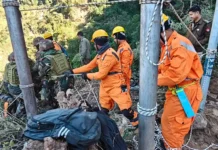Monday Musing
[ Junroi Mamai ]
Governor KT Parnaik recently concluded his visit to Tirap, Changlang and Longding (TCL) districts, and on the sidelines of his tour, the people of the three districts submitted memorandums of demands, notable among them being the longstanding demand of creation of autonomous councils in the TCL districts.
However, it is to be seen whether the central government will concede to such demands sooner or later, as it has been a protracted issue since 2004, and whether such political decisions will gather consensus among the state legislators in the state assembly.
It will evidently have immense implications and consequences for the state in the future as it will affect all the administrative structures of the state.
Creation of autonomous district councils (ADC) is not in itself a new thing; it is enshrined in the 6th Schedule of the Indian Constitution, especially in the tribal areas, for better social, cultural and economic wellbeing of the backward tribal population.
In Arunachal Pradesh, there have been demands for creation of autonomous councils from the people of West Kameng, Tawang, Tirap, Changlang and Longding districts, which has its roots back in early 2000. However, it has not been addressed by Delhi till date. The Parliament has not discussed the issue, though the Arunachal assembly had passed the bill to include the state in the 6th Schedule of the Constitution in 2020.
These facts aside, it also needs to be ensured what kind of autonomy these ADCs would have, if and when the Centre grants the demand. Take for instance the state of Manipur, where the hill areas do not have fully independent ADCs but derive their power from the Manipur state assembly. As a matter of fact, varying powers and functions are allotted to the ADCs.
Moreover, the people in Manipur’s hill areas have boycotted elections for over two decades. Will Arunachal do the same for its struggle to gain ADCs?
While placing demands for ADCs, all stakeholders, including the total 60 legislative members and three MPs of the state, should converge into one strong unanimous agreement and first chart out the structure of the ADC, its powers, functions and limitations, before taking the issue to the central government.
The point is, autonomy should be shifted to the people in real terms, basically for protection, preserving and development of indigenous people not just in letter but in spirit also.
The fact is, a lot of technicalities are involved in achieving ADCs in Arunachal. Only four states are included in the 6th Schedule of the Constitution, and Arunachal is not one of them. If ever the demands are granted, it will undoubtedly be a statutory provision and not constitutional, and therefore will have many limitations like Manipur’s Sadar Hill ADC.
It will be just a political gimmick, not autonomy in real terms. It will still depend on the state’s assembly for many things, including financially. The difference will only matter in shifting the power centre from the legislative to the executive head. The present situation in Manipur is evident to all. People will have to think seriously on this issue. What kind of ADC would Delhi offer us?

